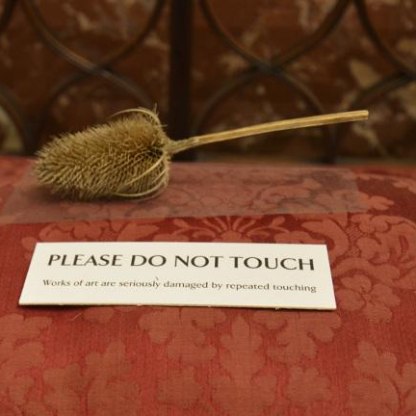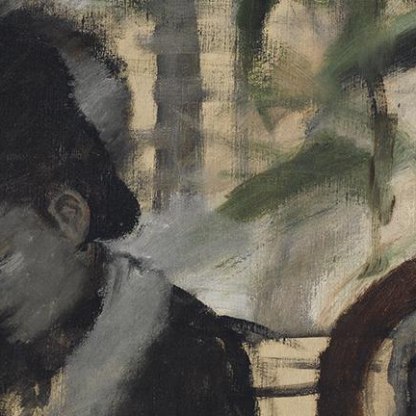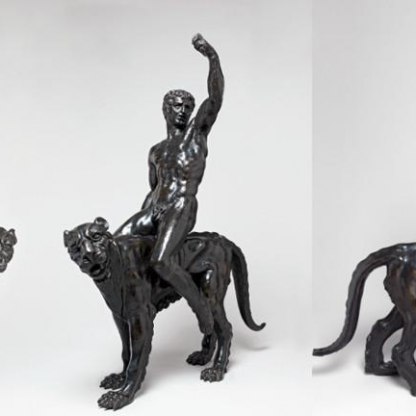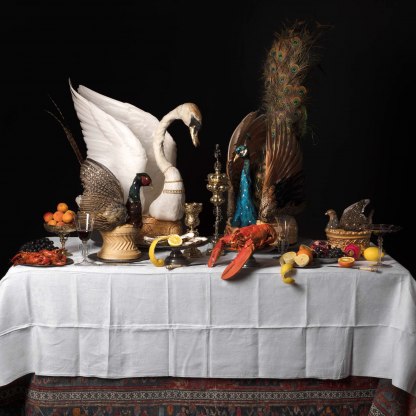Dr Dr Victoria Avery
Keeper European Sculpture & Decorative Arts
Dr Victoria Avery is co-curator of Black Atlantic: Power, People, Resistance and has been Keeper of European Sculpture and Decorative Arts at the Fitzwilliam Museum, University of Cambridge, since 2010 prior to which she was Associate Professor in the Department of Art History at the University of Warwick. Formerly a Fellow of the Society of Antiquaries, Director of Studies for History of Art at St Catharine’s College, Cambridge and Lay Canon and Non-residentiary Member of Chapter of Ely Cathedral, Vicky currently sits on the editorial board of Ricche Minere and is Emerita Lay Canon of the Chapter of Ely Cathedral.
Vicky’s primary field of expertise is European sculpture from 1400 to the present day, especially that produced in early modern Italy, with a focus on Venetian Renaissance sculpture especially that by Alessandro Vittoria (the focus of her 1996 Cambridge PhD thesis) and his circle. She has researched, lectured and published widely on all aspects of Italian Renaissance sculpture. Her British Academy sponsored Vulcan’s Forge in Venus’s City: The Story of Bronze in Venice 1350–1650 (2011), awarded the Premio Salimbeni in 2012, exemplifies her preferred archival and object-based methodologies. Her most recent large-scale sculpture enterprise was a 2-year interdisciplinary research project focussed on the authorship, patronage, making and meaning of the Rothschild bronzes, which resulted in a major interdisciplinary conference and multi-author book, Michelangelo: Sculptor in Bronze (2018). Vicky’s current European sculptural research interests include materials and materiality, making and commissioning processes, meanings and iconography, collecting and display, provenance and the sculpture art market. She is currently leading a new digital research project, Representations of Black People in European Sculpture, 1450–1950.
Vicky also has broad knowledge of and interest in the decorative arts of early modern Europe, especially in terms of making, materiality, usage, collecting and display. She has curated numerous research-led interdisciplinary exhibitions, including Treasured Possessions (2015), Madonnas & Miracles (2017) and Feast & Fast: The Art of Food in Europe (2019–2020). These have resulted in several conferences including, most recently, the CRASSH-funded symposium, Power, Promise, Politics: The Pineapple from Columbus to Del Monte (2020), which is being expanded into a multi-author volume, The pineapple from domestication to commodification: Re-presenting a global fruit, for the Proceedings of the British Academy (2024). Vicky’s broad-based knowledge of European visual and material culture, and her interests in interdisciplinarity and re-examining the past through a decolonising lens has led to her active involvement in the UCM Legacies of Enslavement and Empire project. She is Co-Curator of the legacies-focussed exhibition Black Atlantic: Power, People, Resistance (8 September 2023 – 7 January 2024) and Co-Editor of the accompanying book. She has been nominated Lead Curator of the Fitzwilliam’s second legacies exhibition (February – June 2025), for which she is currently researching the presence of Black abolitionists, activists and performers in Cambridge in the later 18th and 19th centuries.
Vicky lectures and examines regularly for the Department of Art History and Faculty of History at the University of Cambridge as well as undertaking object-based teaching for BA, MA/MPhil degrees in English, Medieval and Modern Languages and Theology. She would welcome applications from prospective MPhil and PhD students whose intended research relates to her current research interests: please contact her in advance if you are considering making an application.
Books (single authored)
- Victoria Avery, Vulcan’s Forge in Venus’ City: The Story of Bronze in Venice, 1350–1650 (London: British Academy/OUP, 2011), 496 pages (awarded XXX Premio Salimbeni per la Storia e la Critica d’Arte in 2011)
- Victoria Avery, Renaissance and Baroque Bronzes from the Fitzwilliam Museum, Cambridge (London: Gli Ori, 2002), 341 pages
Books (joint authored)
- Victoria Avery and Paul Joannides, A Michelangelo Discovery: The Rothschild bronzes and the case for their proposed attribution (Cambridge: Fitzwilliam Museum, 2015), 83 pages
Edited volumes and exhibition catalogues
- Victoria Avery and Melissa Calaresu (eds), The pineapple from domestication to commodification: Re-presenting a global fruit (Proceedings of the British Academy, forthcoming 2024)
- Victoria Avery and Jack Subryan Richards (eds), Black Atlantic: Power, People, Promise (London: PWP/Bloomsbury, 2023), 192 pages
- Victoria Avery and Melissa Calaresu (eds), Feast & Fast: The Art of Food in Europe, 1500–1800 (London: Philip Wilson, 2019), 271 pages
- Victoria Avery (ed.), Michelangelo Sculptor in Bronze (London: Philip Wilson, 2018), 352 pages
- Victoria Avery, Melissa Calaresu and Mary Laven (eds), Treasured Possessions from the Renaissance to the Enlightenment (London: Philip Wilson, 2015), 290 pages
- Victoria Avery and Matteo Ceriana, L’Industria artistica del bronzo del Rinasciemento a Venezia e nell’Italia settentrionale (Verona: Scripta, 2007), 479 pages
Refereed papers in journals
- Victoria Avery and Emma Jones, ‘Family matters: Jacopo Sansovino’s Monument to Doge Francesco Venier in San Salvador, Venice’, Colnaghi Studies Journal, vol. 8 (March 2021), pp. 88-113
- Victoria Avery, ‘Unless they were really first class, I did not care to have them’: Lt Col. Boscawen and his collection of sculpture’, Sculpture Journal, XII (2004), pp. 86-98
- Victoria Avery, ‘The House of Alessandro Vittoria Reconstructed’, Sculpture Journal, V (2001), pp. 7-32
Contributions to symposia and compiled volumes (referred* or otherwise)
- Victoria Avery and Emma Jones, ‘The Bronzes of San Marco’, in La Basilica di Venezia. San Marco: Arte, Storia, Conservazione, ed. Ettore Vio, 3 vols (Venice: Marsilio Editori, 2019), vol. 2, pp. 116-143
- Victoria Avery, ‘Introduction’, in Michelangelo Sculptor in Bronze, ed. Victoria Avery (London: Philip Wilson, 2018), pp. 1-7
- Victoria Avery, ‘Young Michelangelo, bronze and the David for France’, in ibid., pp. 22-47
- Victoria Avery, ‘Michelangelo’s bronze Julius II for Bologna’ in ibid., pp. 48-79
- Victoria Avery, ‘Mature Michelangelo and the mastery of metal’ in ibid., pp. 80-105
- Victoria Avery and Emma Jones, ‘Sculpture’, in Collecting & Giving: Highlights from the Sir Ivor and Lady Batchelor Bequest (Cambridge: Fitzwilliam Museum, 2018), pp. 72-87
- Victoria Avery, ‘The Sculpture of Degas: Production and Reproduction’, in Degas: A Passion for Perfection, ed. Jane Munro (New Haven and London: Yale University Press, 2017), pp. 184-201
- Victoria Avery, ‘Material Matters: Bronze and its (non)-employment in the monuments to Venice’s Doges (1475–1625)’, in The Tombs of the Doges of Venice from the Beginning of the Serenissima to 1907, ed. Benjamin Paul (Rome/Venice: Viella, 2016), pp. 267-310
- Victoria Avery, ‘Alessandro Vittoria and the Art of Carving’, in Making and Moving Sculpture in Early Modern Italy, ed. Kelley Helmstutler Di Dio (Farnham, Surrey, and Burlington, VT: Ashgate, 2015), pp. 87-110 [reprinted in paperback by Routledge, 2021]
- Victoria Avery, ‘“Belo et onorato per onor ancho suo”: Alessandro Vittoria’s Zane Altar Reconsidered’ in Santa Maria Gloriosa dei Frari: Devotional Spaces, Images of Piety, ed. Carlo Corsato and Deborah Howard (Padua: Centro Studi Antoniani, 2015), pp. 233-49
- Victoria Avery, ‘Campane, Cavedoni, Candelieri and Caramali: Giacomo Calderari (c.1562–1622), bell-maker and bronze-caster of Venice’, in Carvings, Casts and Collectors: The Art of Renaissance Sculpture, ed. Peta Motture, Emma Jones and Dimitrios Zikos (London: V&A publishing, 2013; 2nd ed. 2014), pp. 236-251
- Victoria Avery, ‘“Due incomparabili donzelle”: Catarina and Anna Castelli, Sister Bell-Makers in Eighteenth-Century Venice’, in Renaissance Studies in Honor of Joseph Connors, ed. Machtelt Israëls and Louis A. Waldman, 2 vols (Florence: Leo S. Olschki Editore, 2013), vol. I, pp. 654-70
- Victoria Avery, ‘La Cappella del Rosario’, ‘78. Profeti e Sibille’, ‘79. Vittorie e rilievi con cherubini’, ‘80. Episodi della vita della Vergine’, ‘83. San Domenico; Santa Giustina’, ‘84. Candelabri’, ’96. Cancelli’ and ‘97. I ‘frammenti Correr’ in La Basilica dei Santi Giovanni e Paolo, Pantheon della Serenissima. Chiese Veneziane 1, ed. Giuseppe Pavanello (Venice: Marcianum Press, 2013), pp. 284-5, 286-7, 288, 288-9, 291-2, 292-3, 325, and 325-6 respectively
- Victoria Avery, ‘I bronzi Zen’, Arte, Storia, Restauri della Basilica di San Marco a Venezia: Da Cappella della Madonna a Cappella Zen. Quaderni della Procuratoria, Anno 2012 (Venice: Marsilio Editori, 2012), pp. 72-83
- Victoria Avery, ‘“Ridotta à perfettione”: The Rebuilding of the Cappella di San Sabba in Sant’Antonin and Artistic Practice in late Cinquecento Venice’, in Chiesa di Sant’Antonin: storia e restauro, ed. Tiziana Favaro (Venice: Soprintendenza per i beni architettonici e paesaggistici di Venezia e laguna, 2010), pp. 155-179
- Victoria Avery, ‘Dalle bocche da fuoco alla vere da pozzo: la produzione artistica dei fonditori d’artigliera di stato nella Venezia del Rinascimento’, in L’Industria Artistica del Bronzo nella Venezia e nell’Italia settentrionale del Rinascimento, ed. Victoria Avery and Matteo Ceriana (Verona: Scripta, 2008), pp. 303-344
- Victoria Avery, ‘Virtue, Valour, Victory: The Making and Meaning of Bronze Equestrian Monuments (ca. 1440–ca. 1640)’, in Praemium Virtutis III: Reiterstandbilder von der Antike bis zum Klassizismus. Symbolische Kommunikation und gesellschaftliche Wertesysteme, ed.
- Joachim Poeschke, Thomas Weigel and Britta Kusch-Arnhold. Schriftenreihe des Sonderforschungsbereichs 496; vol. 22 (Münster: Rhema, 2008), pp. 199-233
- Victoria Avery, ‘Brazen Images and Sounding Brass: The Significance and Use of Bronze in Christian Contexts’, in The Lion Companion to Christian Art, ed. M.P. Brown (Oxford, 2008), pp. 230-31
- Victoria Avery, ‘The Production, Display and Reception of Bronze Heads and Busts in Renaissance Venice and Padua: Surrogate Antiques’, in Kopf / Bild. Die Büste in Mittelalter und Früher Neuzeit, ed. Jeanette Kohl and Rebecca Müller (Münich and Berlin: Deutscher Kunstverlag, 2007), pp. 75-112
- Victoria Avery, ‘Alessandro Vittoria’s Socles: Shaping and Naming’ in Display and Displacement: Sculpture and the Pedestal from Renaissance to Post-Modern, ed. Alexandra Gerstein (London: Paul Holberton, 2007), pp. 16-32
- Victoria Avery, ‘“Giovene di spirito et d’ingegno”: New Light on the Life and Work of the Venetian Renaissance Bronze Caster Marcantonio di Niccolò di Conti (1576-1638)’ in Der Unbestechliche Blick. Festschrift zu Ehren von Wolfgang Wolters Zu seinem siebzigsten Geburtstag, ed. M. Gaier, B. Nicolai and T. Weddigen (Trier: Porta Alba Verlag, 2005), pp. 437-63
- Victoria Avery, ‘Giovanni Francesco Rustici, Mercury Taking Flight’, in Leonardo da Vinci, Michelangelo and the Renaissance in Florence, ed. David Franklin (exh. cat. National Gallery of Canada with Yale University Press: Ottawa, 2005), pp. 72-73
- Victoria Avery, ‘Scultore dell’Italia settentrionale, Tondi bronzei del portale di palazzo Castelli-Prosperi-Sacrati’ in Gli Este a Ferrara: Il Camerino di alabastro: Antonio Lombardo e la scultura all’antica, ed. Matteo Ceriana (exh. cat. Ferrara, 2004), pp. 244-47
- Victoria Avery, ‘Alessandro Vittoria, Medal of Francisco de Toledo’; ‘Danese Cattaneo (attributed), Medal of Two Unidentified Young Women’; ‘Andrea Briosco, called Riccio, Moses with the Features of Jupiter Ammon’ in In the Light of Apollo: Italian Renaissance and Greece, ed. Mina Gregori (exh. cat. Athens, 2004), pp. 155-56, 160.
- Victoria Avery, ‘Campagna, Girolamo’ and ‘Vittoria, Alessandro’, in The Encyclopedia of Sculpture, ed. Antonia Boström (New York and London: Fitzroy Dearborn, 2004), pp. 238-42 and 1736-40 respectively
- Victoria Avery, ‘State and Private Bronze Foundries in Cinquecento Venice: New Light on the Alberghetti and di Conti Workshops’ in Large Bronzes in the Renaissance, ed. Peta Motture. Studies in the History of Art 64, Symposium Papers XLI (Washington, D.C.: CASVA, National Gallery of Art, 2003), pp. 241-75
- ‘Alessandro Vittoria: The Michelangelo of Venice?’, in Reactions to the Master: Michelangelo’s Effect on Art and Artists in the Sixteenth Century, ed. Francis Ames-Lewis and Paul Joannides (Aldershot: Ashgate, 2003), pp. 157-79
- Victoria Avery, ‘Nuove fonti archivistiche per il rinnovo cinquecentesco della Cappella del Rosario ai Santi Giovanni e Paolo’ in Alessandro Vittoria e l’arte veneta della maniera, ed. Lorenzo Finocchi-Ghersi (Udine: Forum, 2001), pp. 175-97
- Victoria Avery, ‘La Bottega di Alessandro Vittoria’ and ‘Alessandro Vittoria collezionista’, in “La bellissima maniera”: Alessandro Vittoria e la scultura veneta del Cinquecento, ed. Andrea Bacchi, Lia Camerlengho and Manfred Leithe-Jasper (exh. cat., Castello del Buonconsiglio, Trent, 1999), pp. 126-39 and 141-51
Associated Research Projects
Associated Departments
Sign up to our emails
Be the first to hear about our news, exhibitions, events and more…
.jpg?key=directus-large-contain)






.jpg?key=exhibition)
